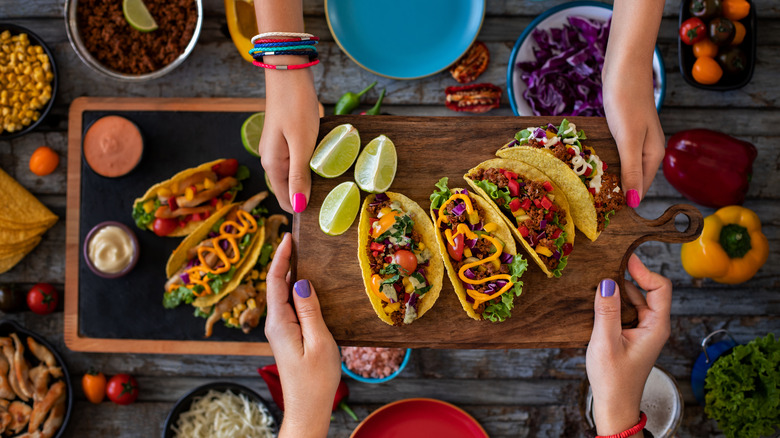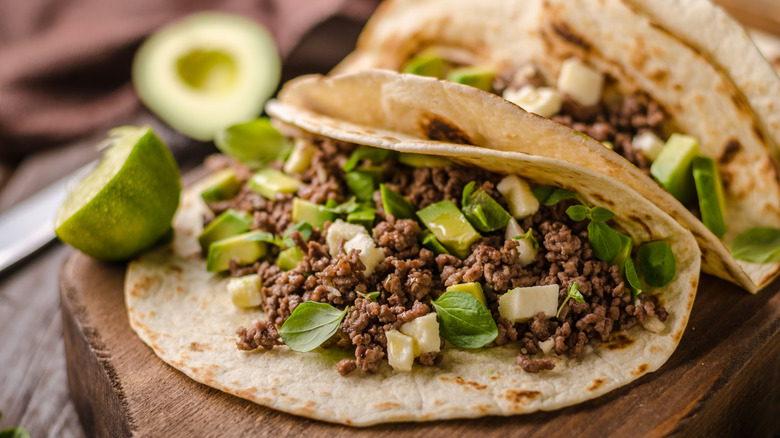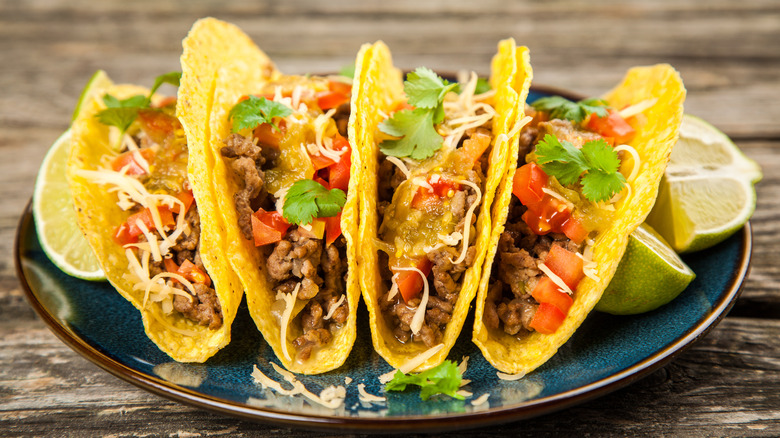The Taco Variety That's Uncommon In Mexico
If you've ever eaten your way across Mexico, then you already know that the cuisines south of the border are the stuff dreams are made of. From crispy chilaquiles bathed in spicy salsa to soft, steaming quesadillas stuffed with molten cheese to warming pozole spritzed with lime and dusted with ground oregano, it's pretty much impossible to eat badly in Mexico.
As much as limited U.S. interpretations of Mexican cuisine would have eaters believe otherwise, Mexican food is incredibly varied across the country's 32 states, ranging far beyond cheesy enchiladas and creamy guac to intricate, nuanced dishes such as chocolate-laced Oaxacan mole and the meaty goat soup known as barbacoa (via Saveur), and, of course, to tacos — those little tortillas stuffed with a variety of fillings that seems endless, from porky carnitas to chewy beef tongue to deep-fried fish.
Because a taco can refer to any type of filling or leftovers that's folded into a tortilla, there's almost no limit to what a taco can consist of. But even if you spent months traveling around Mexico, there's one taco type you're incredibly unlikely to find: The hard-shell taco that's so common north of the border.
In Mexico, tacos are usually soft
People raised in the United States have undoubtedly chowed down on our fair share of hard-shell tacos, those fried-until-crispy tortilla "boats" that come packaged in a box from the supermarket and are typically filled with seasoned ground beef, sour cream, shredded lettuce, and shredded cheddar cheese. A quick and crowd-pleasing choice for dinner at home, hard-shell tacos are also, of course, a favorite at Mexican and Tex-Mex chains such as Taco Bell, and might even be the type of taco most Americans think of when they hear the word.
But hard-shell tacos are simply not common in Mexico, where the tortillas used — whether made of corn or, far less commonly, wheat — are almost always soft (via Casa Bonita). While it's true that you can find taco variations, including the taquito, which consists of a soft tortilla rolled up tightly around a filling and then deep-fried until it resembles a crunchy cigar, and taco dorados, which are fried-until-crispy tacos that are different from hard-shell tacos in the respect that they consist of fillings packed into a soft tortilla and then fried (via Bake It With Love), the word "taco" nearly always refers to a soft version in Mexico.
Hard-shell tacos are an American invention
Los Angeles Times columnist and author of "Taco USA: How Mexican Food Conquered America," Gustavo Arellano, told MEL Magazine that the type of tacos Mexican immigrants first brought to the U.S. were tacos dorados.
But it wasn't until a supermarket brand of canned Mexican stews, fillings, and sauces debuted in the 1930s that the idea of a separately-fried hard taco shell became a thing. That brand was George Ashley's El Paso-based Absolute Mexican food, Arellano shared in his book, via What's Up, and among its offerings of canned enchilada sauce and canned soft corn tortillas was a metal taco mold which could be used at home to fry the canned tortillas into that crispy, pocket-shaped result. "[Fifteen] years before the first patent issued for a taco fryer, George fashioned one capable of cooking 600 shells per hour," Arellano wrote.
Later, inspired by the tacos dorados fried up at San Bernardino's Mitla Cafe, Glen Bell, the founder of Taco Bell, created his own "Crunchy Taco" — featuring a shell fried separately — in 1951, according to the chain's official website. And the rest, so they say, is history.


